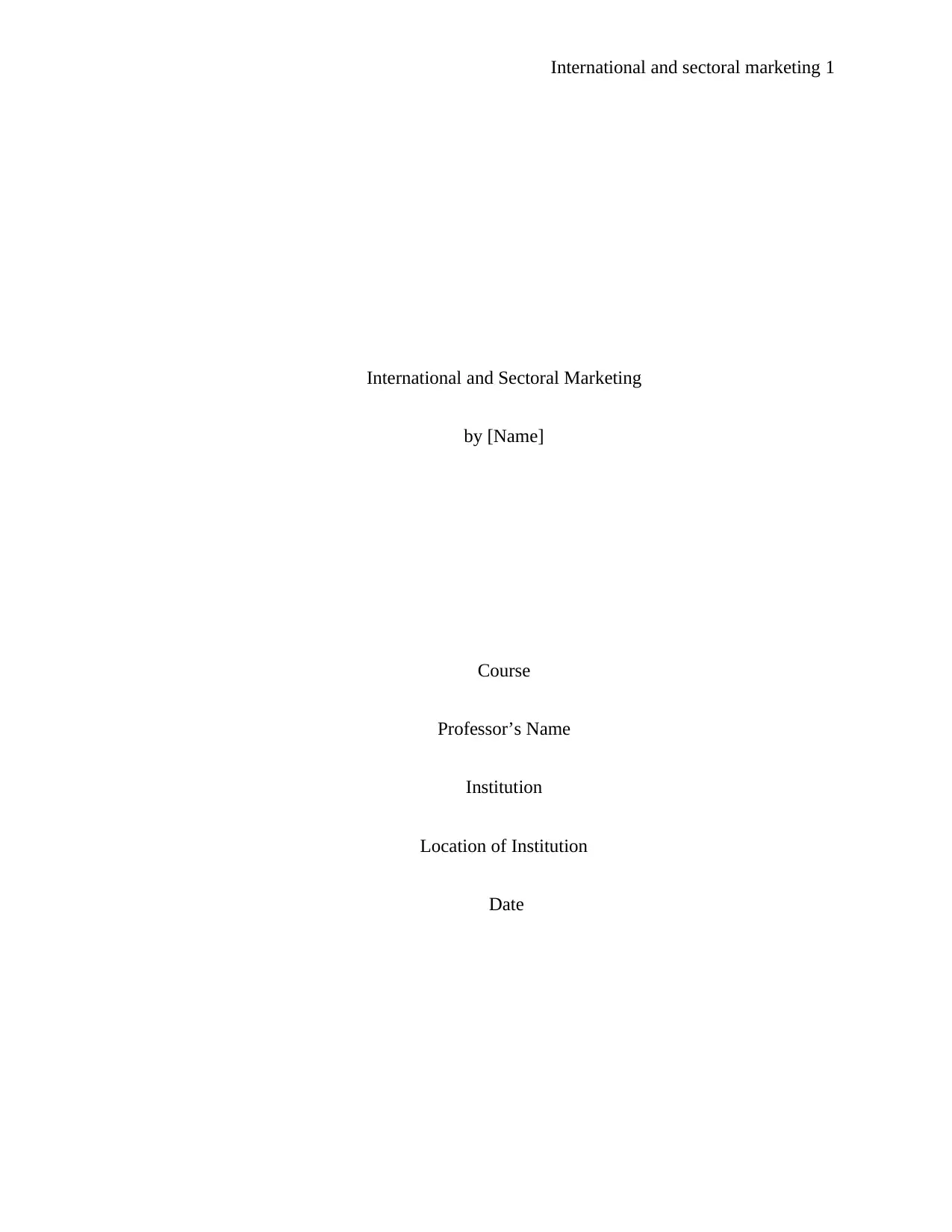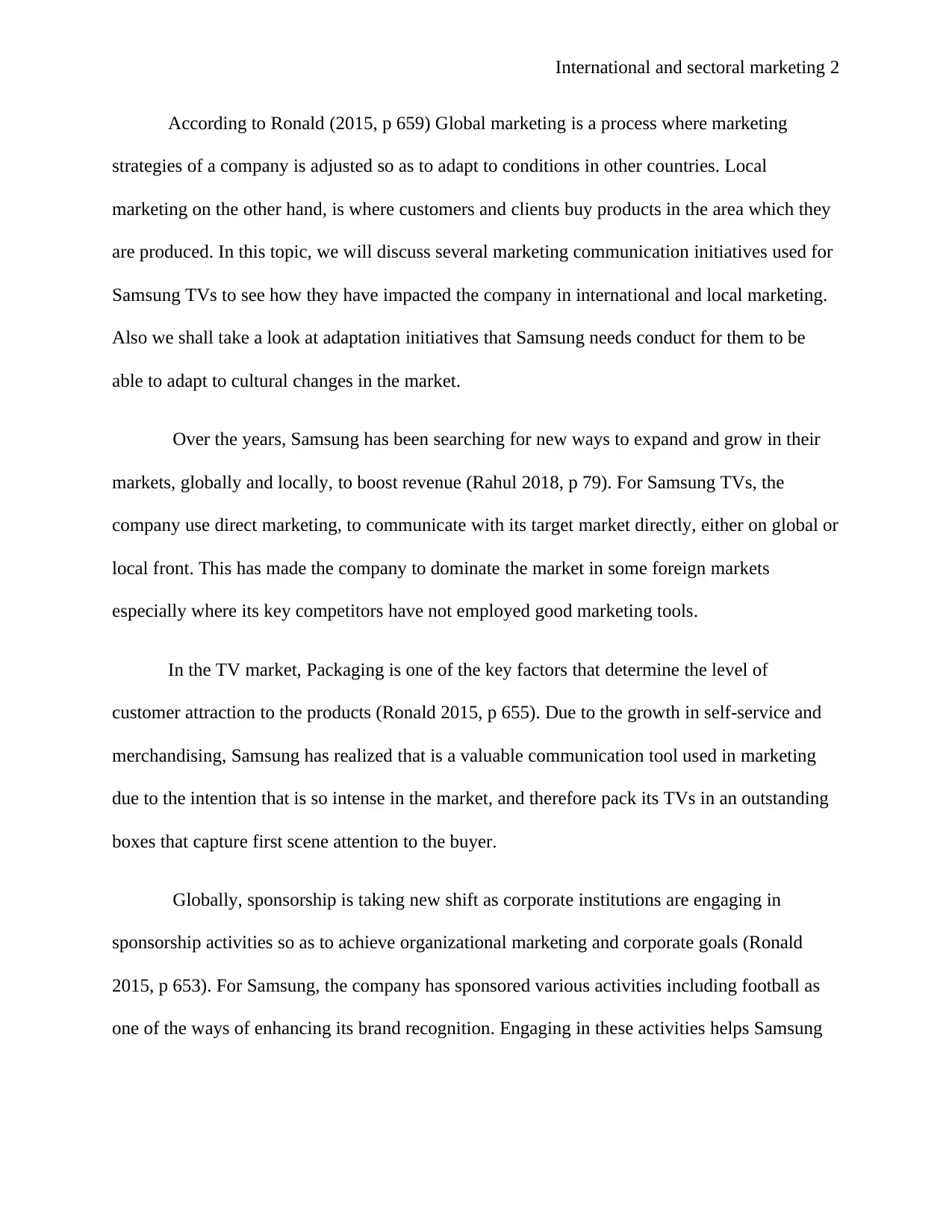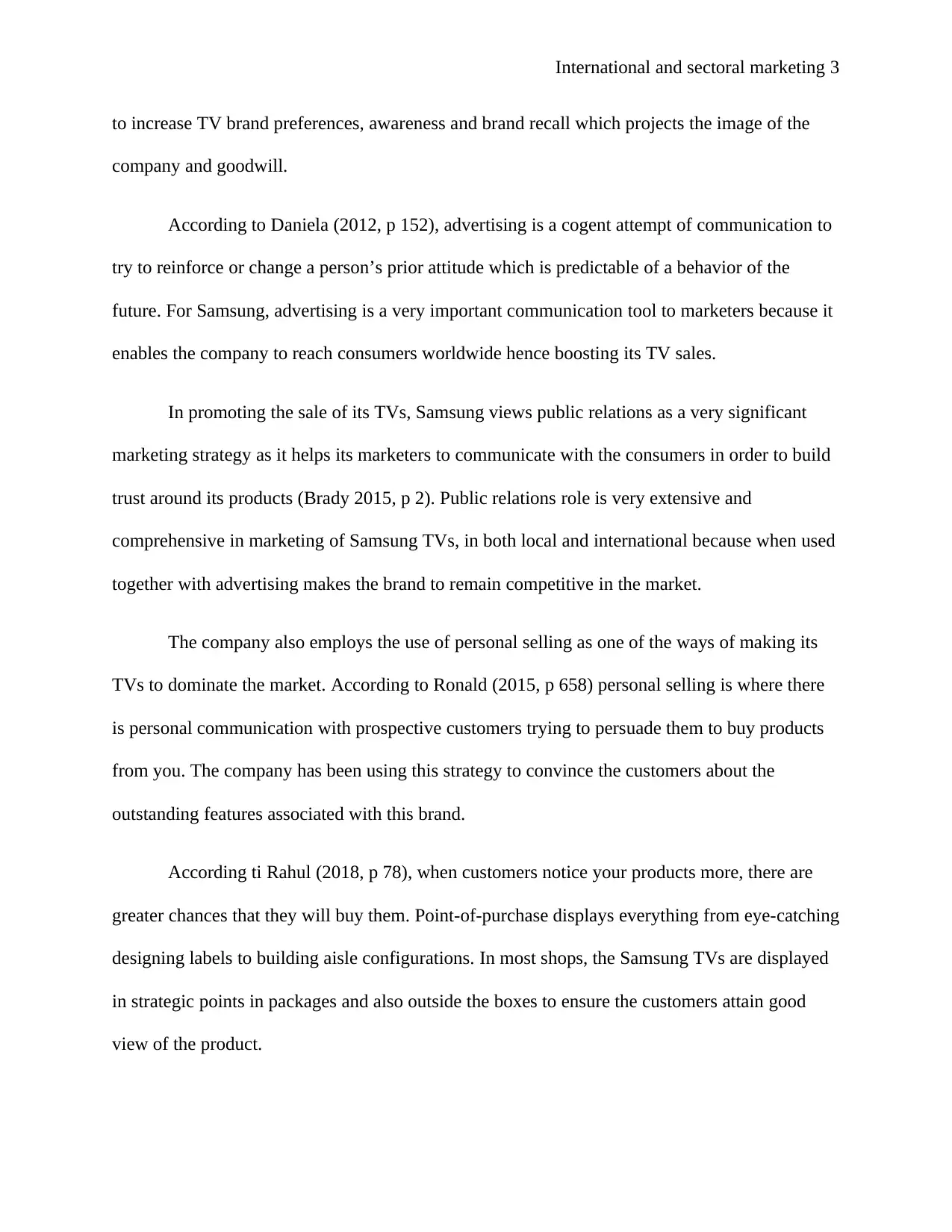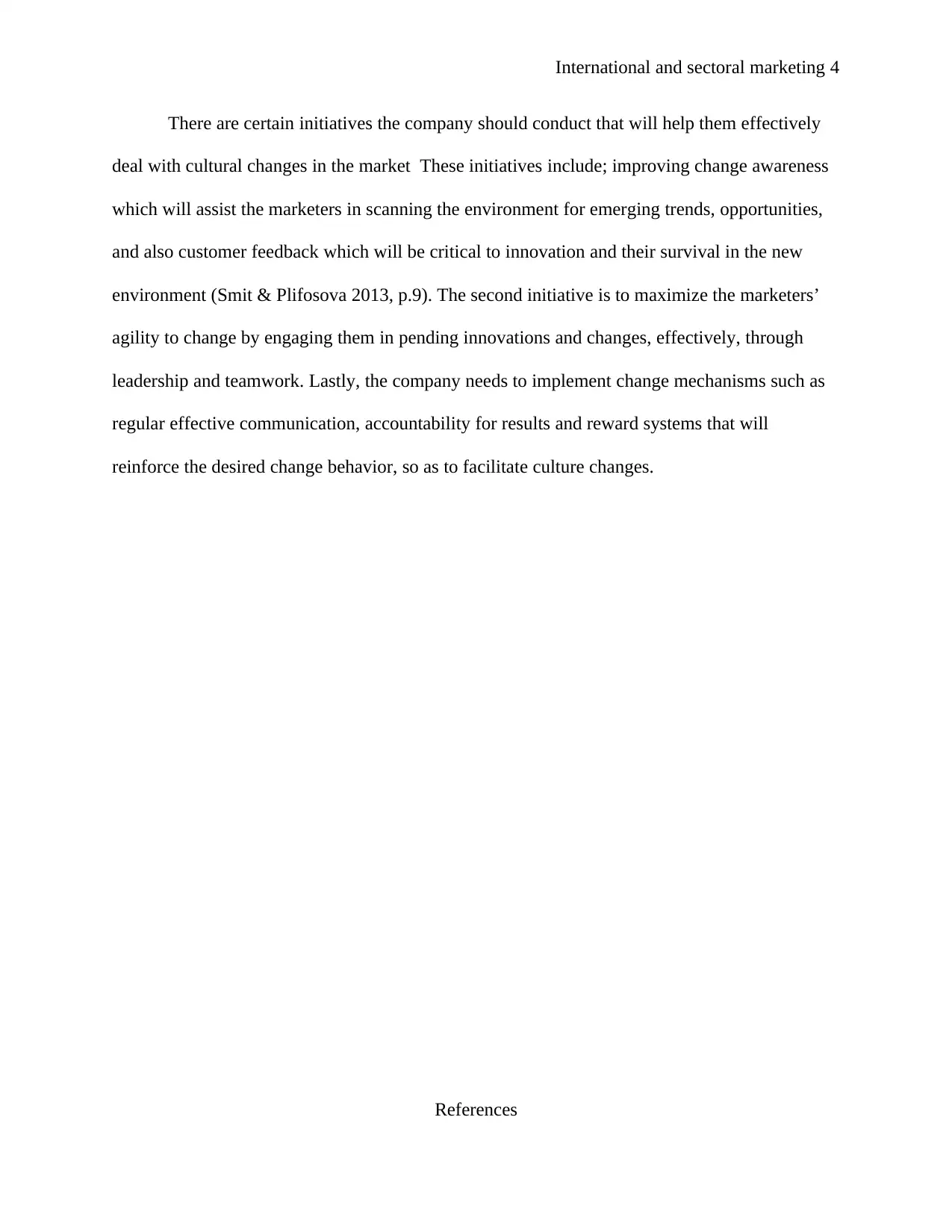Samsung TVs: International and Sectoral Marketing Strategies Analysis
VerifiedAdded on 2023/06/07
|5
|952
|299
Report
AI Summary
This report provides an analysis of Samsung's international and sectoral marketing strategies, focusing on how the company adapts its marketing efforts to different global and local markets. It examines various communication initiatives employed by Samsung for its TVs, including direct marketing, packaging, sponsorship, advertising, public relations, and personal selling. The report highlights how these strategies have contributed to Samsung's market dominance and brand recognition. Furthermore, it discusses the importance of cultural adaptation and suggests initiatives such as improving change awareness, maximizing marketers' agility, and implementing effective change mechanisms to navigate cultural changes successfully. The report draws upon academic sources and industry insights to provide a comprehensive overview of Samsung's marketing approach.

International and sectoral marketing 1
International and Sectoral Marketing
by [Name]
Course
Professor’s Name
Institution
Location of Institution
Date
International and Sectoral Marketing
by [Name]
Course
Professor’s Name
Institution
Location of Institution
Date
Paraphrase This Document
Need a fresh take? Get an instant paraphrase of this document with our AI Paraphraser

International and sectoral marketing 2
According to Ronald (2015, p 659) Global marketing is a process where marketing
strategies of a company is adjusted so as to adapt to conditions in other countries. Local
marketing on the other hand, is where customers and clients buy products in the area which they
are produced. In this topic, we will discuss several marketing communication initiatives used for
Samsung TVs to see how they have impacted the company in international and local marketing.
Also we shall take a look at adaptation initiatives that Samsung needs conduct for them to be
able to adapt to cultural changes in the market.
Over the years, Samsung has been searching for new ways to expand and grow in their
markets, globally and locally, to boost revenue (Rahul 2018, p 79). For Samsung TVs, the
company use direct marketing, to communicate with its target market directly, either on global or
local front. This has made the company to dominate the market in some foreign markets
especially where its key competitors have not employed good marketing tools.
In the TV market, Packaging is one of the key factors that determine the level of
customer attraction to the products (Ronald 2015, p 655). Due to the growth in self-service and
merchandising, Samsung has realized that is a valuable communication tool used in marketing
due to the intention that is so intense in the market, and therefore pack its TVs in an outstanding
boxes that capture first scene attention to the buyer.
Globally, sponsorship is taking new shift as corporate institutions are engaging in
sponsorship activities so as to achieve organizational marketing and corporate goals (Ronald
2015, p 653). For Samsung, the company has sponsored various activities including football as
one of the ways of enhancing its brand recognition. Engaging in these activities helps Samsung
According to Ronald (2015, p 659) Global marketing is a process where marketing
strategies of a company is adjusted so as to adapt to conditions in other countries. Local
marketing on the other hand, is where customers and clients buy products in the area which they
are produced. In this topic, we will discuss several marketing communication initiatives used for
Samsung TVs to see how they have impacted the company in international and local marketing.
Also we shall take a look at adaptation initiatives that Samsung needs conduct for them to be
able to adapt to cultural changes in the market.
Over the years, Samsung has been searching for new ways to expand and grow in their
markets, globally and locally, to boost revenue (Rahul 2018, p 79). For Samsung TVs, the
company use direct marketing, to communicate with its target market directly, either on global or
local front. This has made the company to dominate the market in some foreign markets
especially where its key competitors have not employed good marketing tools.
In the TV market, Packaging is one of the key factors that determine the level of
customer attraction to the products (Ronald 2015, p 655). Due to the growth in self-service and
merchandising, Samsung has realized that is a valuable communication tool used in marketing
due to the intention that is so intense in the market, and therefore pack its TVs in an outstanding
boxes that capture first scene attention to the buyer.
Globally, sponsorship is taking new shift as corporate institutions are engaging in
sponsorship activities so as to achieve organizational marketing and corporate goals (Ronald
2015, p 653). For Samsung, the company has sponsored various activities including football as
one of the ways of enhancing its brand recognition. Engaging in these activities helps Samsung

International and sectoral marketing 3
to increase TV brand preferences, awareness and brand recall which projects the image of the
company and goodwill.
According to Daniela (2012, p 152), advertising is a cogent attempt of communication to
try to reinforce or change a person’s prior attitude which is predictable of a behavior of the
future. For Samsung, advertising is a very important communication tool to marketers because it
enables the company to reach consumers worldwide hence boosting its TV sales.
In promoting the sale of its TVs, Samsung views public relations as a very significant
marketing strategy as it helps its marketers to communicate with the consumers in order to build
trust around its products (Brady 2015, p 2). Public relations role is very extensive and
comprehensive in marketing of Samsung TVs, in both local and international because when used
together with advertising makes the brand to remain competitive in the market.
The company also employs the use of personal selling as one of the ways of making its
TVs to dominate the market. According to Ronald (2015, p 658) personal selling is where there
is personal communication with prospective customers trying to persuade them to buy products
from you. The company has been using this strategy to convince the customers about the
outstanding features associated with this brand.
According ti Rahul (2018, p 78), when customers notice your products more, there are
greater chances that they will buy them. Point-of-purchase displays everything from eye-catching
designing labels to building aisle configurations. In most shops, the Samsung TVs are displayed
in strategic points in packages and also outside the boxes to ensure the customers attain good
view of the product.
to increase TV brand preferences, awareness and brand recall which projects the image of the
company and goodwill.
According to Daniela (2012, p 152), advertising is a cogent attempt of communication to
try to reinforce or change a person’s prior attitude which is predictable of a behavior of the
future. For Samsung, advertising is a very important communication tool to marketers because it
enables the company to reach consumers worldwide hence boosting its TV sales.
In promoting the sale of its TVs, Samsung views public relations as a very significant
marketing strategy as it helps its marketers to communicate with the consumers in order to build
trust around its products (Brady 2015, p 2). Public relations role is very extensive and
comprehensive in marketing of Samsung TVs, in both local and international because when used
together with advertising makes the brand to remain competitive in the market.
The company also employs the use of personal selling as one of the ways of making its
TVs to dominate the market. According to Ronald (2015, p 658) personal selling is where there
is personal communication with prospective customers trying to persuade them to buy products
from you. The company has been using this strategy to convince the customers about the
outstanding features associated with this brand.
According ti Rahul (2018, p 78), when customers notice your products more, there are
greater chances that they will buy them. Point-of-purchase displays everything from eye-catching
designing labels to building aisle configurations. In most shops, the Samsung TVs are displayed
in strategic points in packages and also outside the boxes to ensure the customers attain good
view of the product.
⊘ This is a preview!⊘
Do you want full access?
Subscribe today to unlock all pages.

Trusted by 1+ million students worldwide

International and sectoral marketing 4
There are certain initiatives the company should conduct that will help them effectively
deal with cultural changes in the market These initiatives include; improving change awareness
which will assist the marketers in scanning the environment for emerging trends, opportunities,
and also customer feedback which will be critical to innovation and their survival in the new
environment (Smit & Plifosova 2013, p.9). The second initiative is to maximize the marketers’
agility to change by engaging them in pending innovations and changes, effectively, through
leadership and teamwork. Lastly, the company needs to implement change mechanisms such as
regular effective communication, accountability for results and reward systems that will
reinforce the desired change behavior, so as to facilitate culture changes.
References
There are certain initiatives the company should conduct that will help them effectively
deal with cultural changes in the market These initiatives include; improving change awareness
which will assist the marketers in scanning the environment for emerging trends, opportunities,
and also customer feedback which will be critical to innovation and their survival in the new
environment (Smit & Plifosova 2013, p.9). The second initiative is to maximize the marketers’
agility to change by engaging them in pending innovations and changes, effectively, through
leadership and teamwork. Lastly, the company needs to implement change mechanisms such as
regular effective communication, accountability for results and reward systems that will
reinforce the desired change behavior, so as to facilitate culture changes.
References
Paraphrase This Document
Need a fresh take? Get an instant paraphrase of this document with our AI Paraphraser

International and sectoral marketing 5
Brady, DL 2015, Essentials of International Marketing, London, Routledge
Daniela, I 2012, Entrepreneurial Marketing: A New Approach for Challenging Times,
Management & Marketing, Vol. 7, no. 1, pp.143-154.
Rahul, G 2018, Marketing – A Critical Text Book. South Asian Journal of Management, vol. 25,
no. 1, pp.78-98.
Ronald, B 2015, Marketing Channel Integration -A Review of Current Debates. Advances in
Management, vol. 8, no. 5, pp. 653-687.
Smit B. and Pilifosova, O 2013, Adaptation to cultural change in the context of sustainable
development and equity, Sustainable Development, vol. 8, no. 9, p.9.
Brady, DL 2015, Essentials of International Marketing, London, Routledge
Daniela, I 2012, Entrepreneurial Marketing: A New Approach for Challenging Times,
Management & Marketing, Vol. 7, no. 1, pp.143-154.
Rahul, G 2018, Marketing – A Critical Text Book. South Asian Journal of Management, vol. 25,
no. 1, pp.78-98.
Ronald, B 2015, Marketing Channel Integration -A Review of Current Debates. Advances in
Management, vol. 8, no. 5, pp. 653-687.
Smit B. and Pilifosova, O 2013, Adaptation to cultural change in the context of sustainable
development and equity, Sustainable Development, vol. 8, no. 9, p.9.
1 out of 5
Related Documents
Your All-in-One AI-Powered Toolkit for Academic Success.
+13062052269
info@desklib.com
Available 24*7 on WhatsApp / Email
![[object Object]](/_next/static/media/star-bottom.7253800d.svg)
Unlock your academic potential
Copyright © 2020–2025 A2Z Services. All Rights Reserved. Developed and managed by ZUCOL.





